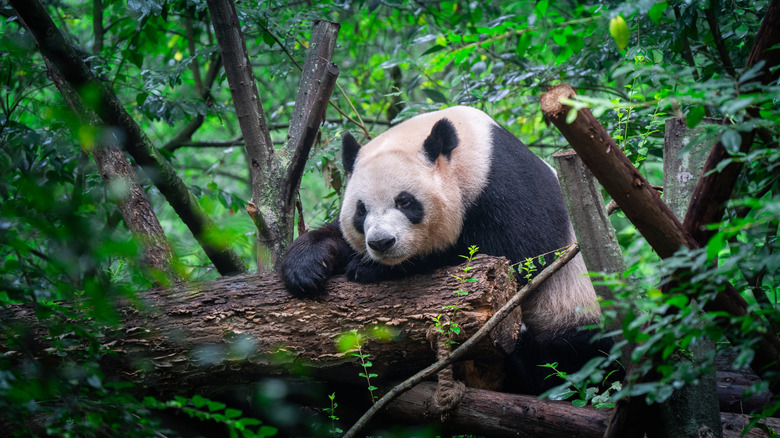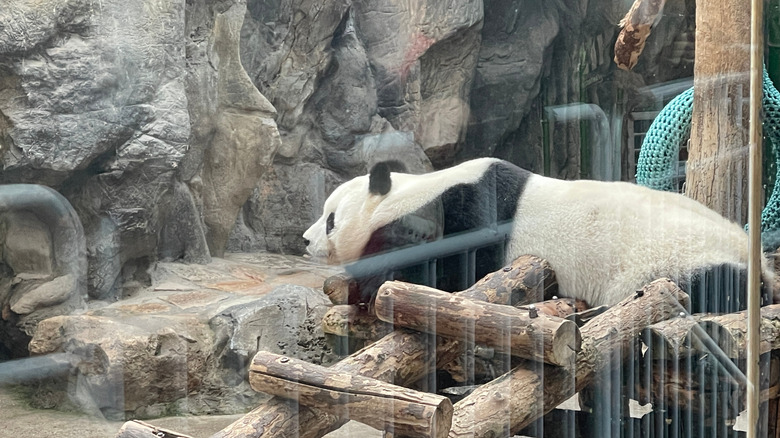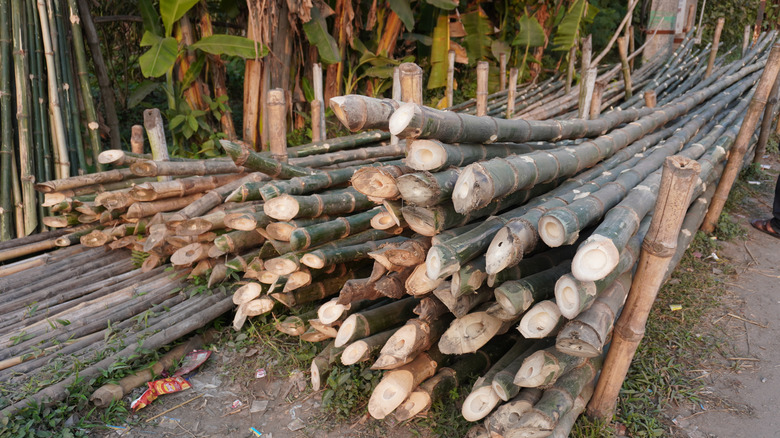Why We're Stunned Pandas Haven't Become Extinct
If you've ever watched a captive panda go about its daily business, you may have wondered how the clumsy creatures ever managed to survive in the wild. After all, extant animals are those that have evolved the skills and traits to help them survive. But "survival skills" is one of the last phrases to come to mind when looking at a panda.
Pandas in zoos can be seen stumbling around, falling out of trees, struggling to regain their balance, and generally bumbling about. They're equally as clumsy in the wild since they do very little other than rolling around and munching on bamboo for up to 15 hours a day. And because bamboo provides such little energy, pandas are extremely sluggish.
Pandas can get away with their clumsy, lethargic behavior because they lack natural predators. Some animals, like the snow leopard, may occasionally prey on baby panda cubs, but the giant size and powerful bite of a full-grown panda mother is usually enough to protect their young. Yet, while pandas' apparent lack of agility can be explained, pandas face other challenges that could be a death sentence for the species.
The fact of the matter is that the giant panda is indeed threatened by extinction, but it's not its fault. Unlike squirrels and pigeons, which have adapted to live in human-created urban environments, pandas are too specialized to adapt to human encroachment upon their habitat. This is because pandas occupy an incredibly narrow ecological niche, a niche that human activity has made even narrower.
Why pandas struggle to adapt: A specialist with nowhere to go
In ecology, a niche is defined as all the biotic and abiotic interactions that a species encounters in its natural environment. These interactions are what shape an organism's life and evolution, like food sources, predators, and weather cycles. A species with a wide niche is called a generalist and can survive in a broad range of conditions, like a raccoon. A species with a narrow niche is called a specialist and can only survive in very specific environmental conditions.
The giant panda is a specialist species because its ecological niche is extremely narrow. For starters, 99% of a panda's diet is composed of just one food: bamboo. And because bamboo is so low in nutrients and energy, pandas need to eat a lot of it. Adults typically spend as much as 16 hours feasting on bamboo shoots and leaves per day, during which they consume 26 to 84 pounds of the stuff. Without vast territories of bamboo forests, pandas can't reach their daily quota needed to survive.
The giant panda's narrow niche is also critical to its reproductive cycle. In the wild, males travel in search of a mate, battling with competitors along the way. That competition doesn't occur in captivity, which may help explain why it's so hard to breed pandas in captivity. Females will mate with multiple males during the breeding season, which occurs between March and May. However, they only ovulate for 24 to 72 hours and produce only one cub at a time. Cubs are tiny, and they can only survive in the wild under the protection of the mother. Outside of the panda's ecological niche, foreign predators, exposure, and a lack of bamboo would make survival impossible.
Pandas aren't a threat to their own survival, we are
The very fact that giant pandas exist is proof that they possess the traits and skills needed to survive in their wild habitat. The same can be said of other species that have been brought to the brink of extinction by human activity, like the humpback whale and the American bison. While these animals are perfectly adapted for survival in their natural environments, it's when human beings hunt and destroy those natural environments that extinction becomes a real possibility.
In fact, one reason we're stunned that pandas haven't become extinct is because of how close they came to being wiped out fewer than 50 years ago. Since the beginning of human development in southwest China, the panda population has shrunk along with its territory. Bamboo forests in southwest China were cleared for agriculture, timber, and development, as dams, highways, and cities further isolated panda territory. Pandas have also been hunted for meat and poached for their pelts, as well as captured for sale to zoos. By the time the crisis began to gain public attention in the 1980s, the population was down to around 1,100 individuals.
Just as human beings almost exterminated pandas, we brought them back, too. Catalyzed by organizations like the World Wildlife Fund, efforts to save the species have had shaky success. Millions of dollars in research funding, forest conservation, and captive breeding programs have boosted the population to the point that the giant panda was delisted as an endangered species in 2016. Now, pandas are classified as vulnerable. It's cause for celebration but also a stark reminder that human-led environmental destruction is the most common reason that animals end up on the brink of extinction, not the species itself.


